I hate pulling. My Dog Pulls. Three words that represent the bane of a surprising number of dog owners lives, with a three word solution: Loose Leash Walking.
First, please know if you’re struggling with this, you are not alone. 82.7% of dog parents in a recent study say that their dog pulls and it’s a problem!
Whether you’re struggling because you’ve got a big dog and her pulling on the leash is hurting you, or you’ve got a little dog, and you’re embarrassed that they just cannot walk nicely. Or you just cannot seem to get it right. Or, if you’re a new puppy parent (Yay! You found your best place!), you just want to get it right, right from the start.
This piece will solve that for you.
How can I say that? Well, I mean, other than the fact that I used to be a dog walker, and not one of my dogs pulled (at least, the ones I trained and kept on my services didn’t – with some cooperation from Mum & Dad…), I’ve also taught a huge spectrum of dogs to walk on that loose leash simply, easily, and effectively with this method.
This means you can take faith that this? Is all you’ll ever need to get your dog to walk nicely.
As always, you need to start with the why.
- Why Does My Dog Pull On His Lead
- Why Won't My Dog Stop Pulling On The Leash?
- Why Your Dog Needs To Walk Loose Leash?
- Loose Leash Vs Heel
- How To Stop Your Dog Pulling On The Leash
- Step 1 – Start With The Right Equipment
- Step 2 – Rewards At The Ready!
- Step 3 – Implement Some General Rules
- Step 4 – Manage The Three D’s
- Step 5 – The Method
- Step 6 – Practice
- Step 7 – Be Consistent.
- Question! Did You Notice I Didn’t Associate This With A Cue Word?
- Notes On Situational Pulling…
- FAQ
- Best Dog Harness For Stopping Pulling
- What Harness Stops A Dog From Pulling?
- What's Best To Stop My Dog Pulling?
- What Lead Stops A Dog Pulling?
- Is It Safe To Walk A Dog That Pulls While Pregnant?
- Can Pulling On A Leash Hurt Puppy?
- Why Does My Dog Pulls On Leash To The Point Of Choking?
- My Dog Barks Whilst He’s Pulling On A Lead, Is That The Same?
- My dog is Pulling And Biting The Leash, What Should I Do?
- My Dog Is Still Pulling With A Gentle Leader, Why?
- Why Is My Dog Pulling Backwards On His Leash?
- Can I Use A Prong Collar or Pinch Collar To Make My Dog Walk Nicely?
- Loose Leash Success!
- Author, Ali Smith
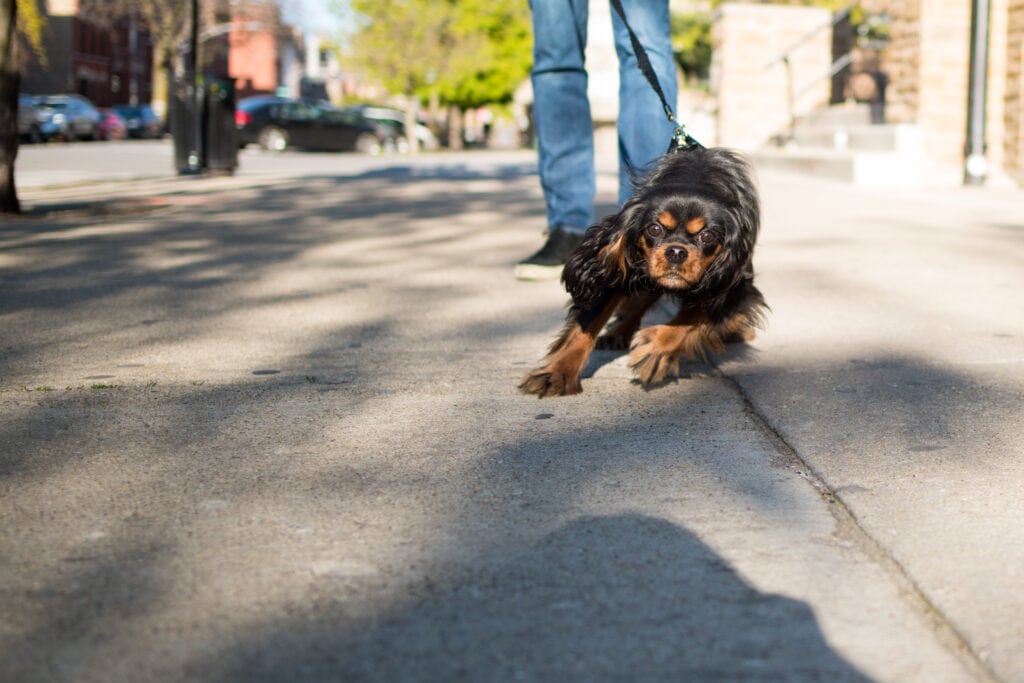
Why Does My Dog Pull On His Lead
There are a few reasons for this. Either
- Your dog wants something that’s over there! See?!
- You walk slower than he or she does.
Normally? It’s the latter, but there will often be a little of the former thrown in for good measure. Knowing what to do when your dog pulls? Isn’t easy.
Why Won’t My Dog Stop Pulling On The Leash?
Because you’re not showing him or her its important in a way that they understand.
How I suggest we do this? Is to make it worth their while.
Rewards! We reward them for doing what we want, and manage the situation when (or ideally before) they start getting it wrong.
Why Your Dog Needs To Walk Loose Leash?
To be honest, you likely already know this, but here it is, nonetheless.
For Your Safety
🚩 De-gloving injuries are one of the most common injuries amongst dog owners – this is caused by a dog that pulls
🚩 This adds strain to your shoulder joints – and even I’ve suffered injuries from pulling dogs!
🚩 Risk to Pregnant women is huge.
🚩 Risk to anyone less able, is substantial
For Your Dog’s Safety
🚩 Dogs who pull often get injuries to their trachea
🚩 Neck strain from head collars is a real threat
This is one of those things that’s fine until it’s not.
Before I trained professionally, I was a dog walker? And I can tell you first-hand that I’ve had a shoulder injury that’s taken a year to heal properly and a finger that got broken injured on separate occasions by one dog who no matter how much I tried? Would not learn leash manners.
Please note: this is not a reflection of my training, he was an adhoc client who I would have for two days or so every few months, he’d improve, then go back to his dad and suddenly he’d have forgotten everything… again. Lovely dog though.
So! Point stands. Your dog needs to be able to walk on a leash.

Loose Leash Vs Heel
To me? Heel is totally unnecessary, a loose leash is pivotal.
Whilst all my dogs can walk at a perfect heel – I don’t ever ask it of them when we’re out walking, it’s an exercise we do more for mental stimulation than for function.
Why? Because your dog, or puppy, doesn’t need to be perfect – they need to be practical. It’s a bloody big difference! (Excuse my french!) but it’s an incredibly important one – at least to me.
I find too many people crucify themselves because their puppy isn’t perfect.
Social media, marketing and the media have so much to answer for on that front and it makes me so mad. Our lives have to be perfect, and that expectation extends to puppy and dog ownership. It puts such huge pressure on us that more and more people are tending to get the puppy blues.
Yep. Wicked isn’t it? I’d bet that’s a reason for dogs ending up in shelters too. Grumble.
This is why I will always steer well clear of the word “Perfect”. It’s wrong.
Tldr; heel is nice, but loose leash is necessary.
Aaaaand back on point….
How To Stop Your Dog Pulling On The Leash
This process is tried, tested and proven. I’ve done it with a huge group of people and successfully with dogs of all ages, sizes, shapes and breeds. So, please don’t use their breed as an excuse not to train.
Don’t Cheat, Just Train.
By cheating, I mean those things that offer miracles and quick solutions. Whilst it likely will achieve their goal? It’s also doing so because it, somehow, causes pain or discomfort to your dog.
That very act creates a problem. Your dogs walks are … well… for your dog. We want our dogs to be comfortable and confident on their walks, not in discomfort. But by the same degree, we don’t want you injured either, and you both need to enjoy it.
Not to mention that the training will never transfer, and you’ll be bound to that ‘tool’ for life.
So, the simplest way of doing that? Is to train a proper loose leash.
Cheaters never prosper, huh?
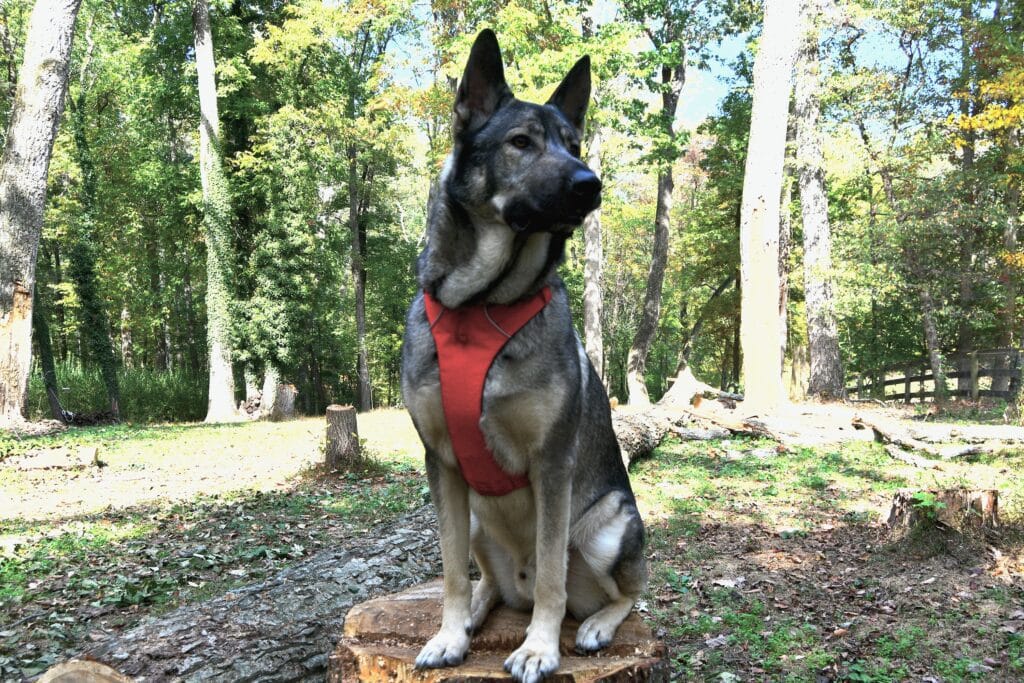
Step 1 – Start With The Right Equipment
Harness and flat leash please!
This means :
❌ no bungee attachments
✅ 6ft leash
❌ no discomfort causing equipment
✅ two point harness
❌ no flexi-leads
You can start learning on a collar, it just means you’ve really got to get it right quicker because of the risk to their neck- so your call!
Which Harness…
✅ Woofles Harness (small)
✅ Ruffwear Front Range (any)
✅ Ruffwear Flagline (any)
✅ Perfect Fit (any*)
*The Perfect-Fit is my favourite, in all honesty, but if your dog has a narrower chest? This may be less than suitable, opt for the Front range instead, it gives a better motion range!
These four? Are ideal harnesses for you and your dog – no matter what size. One of these will work, have a look for yourself, and if you want to chat, come chat! I’ve tried most of them, but bear in mind, I only have big dogs so my knowledge is limited with the smaller woofs.
If you want more harness help? This is the really up to date list that I keep and where you can find all of the harnesses I’ve reviewed to date, listed from my favourite, to my least favourite!
Best Dog Harnesses 2022 – Tried & Tested By A Professional Dog Trainer
Quick Myth Bust! Harnesses DO NOT Encourage Pulling!
Guess what does? You.
No piece of worn equipment is responsible for your dog (or anyone’s dog) pulling. The only thing at fault? Is you, sorry! But that’s the easiest fix in the world! We just have to tell you how to get it right. And you’re doing that right now, so well done!!
Leash
✅ Halti Training Leash
This comes in large size and small sizes – both work wonderfully and I cannot recommend them highly enough. They were my choice for all my dogs when I walked professionally. It’s also double ended and allows for a change of lengths.
The Great Thing About A Two Point Harness & A Double Ended Lead?
You can attach the leash to both parts of the harness. This is wonderful if you’re trying to train a loose leash with a dog that’s used to pulling as it reduces their relative strength with the front point.
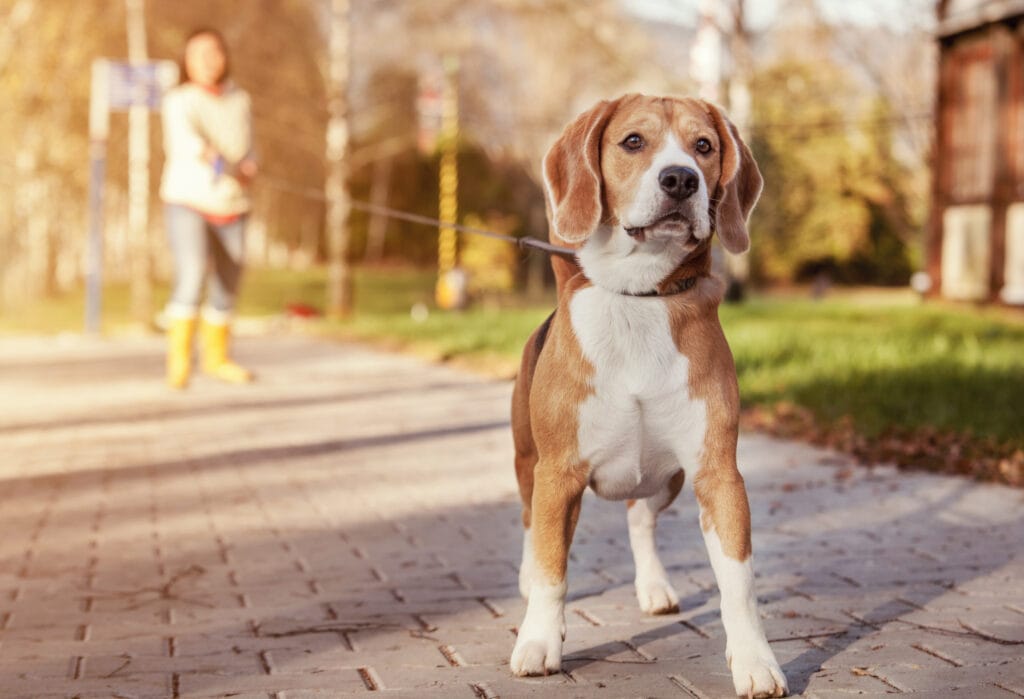
❌ Ditch The Retractable Leash
For now? Ditch this sonnofafemaledog – because it is by virtue of how it functions – rewarding your dog for pulling. The cycle in your dogs head is: I pull > I get more leash. Meaning that when they go on a leash of limited length? They pull, expecting to get more leash, they don’t, they get frustrated and keep pulling.
See the problem?
Step 2 – Rewards At The Ready!
Notice I said rewards here, not treats! Because not all rewards are treats and not all treats are rewards.
Check out the piece on High Value Treats – and if you’re confused in any way, let me know.
Alternatively, consider play as a reward (here’s our top puppy toys! The tug-e-nuff one could work really well here).
These should be used liberally to start with lots of “Good!”, “That’s it!”, “Keep it up, pup!”, because we’re convincing your pup that being with you gives them the good stuff. Be that fun, or food.
Step 3 – Implement Some General Rules
In a family situation, this can be so difficult.
No one who is not an adult should be holding the leash alone. This should go without saying. I see people brag a lot (especially on the german shepherd pages) that their dog is a lamb on a leash, and will walk perfectly with their 4 year old…
My heart drops to see that. Please don’t, whilst cute, it’s a recipe for disaster if the dog bolts for whatever reason. The world is weird and wonderful, let’s avoid injuries where we can!
Start with one person walking your dog. If you’re in a one person household this is easy. But if you use a dog walker or other people are involved (and necessary), make sure they’re on board with the methodology. You could even send them this blog to help them figure it out!
We Stop Saying No. Seriously, no is just going to make you more frustrated. Every time you want to say no? Take a deep breath, turn on your heel and go the other way with a chirpy “This way!” and you’ll start getting him back to the right spot. I’ll cover that more later though!
Step 4 – Manage The Three D’s
So, I’ve written about it here, but essentially? Start in a really low distraction environment, like inside your home, practice in there to start, then work up your yard or garden, or to your street, or to a quite part of the park, and then to in front of a bunch of distractions, but work at a distance from them and slowly make the distance smaller, and the duration you expect the loose leash before a reward longer.
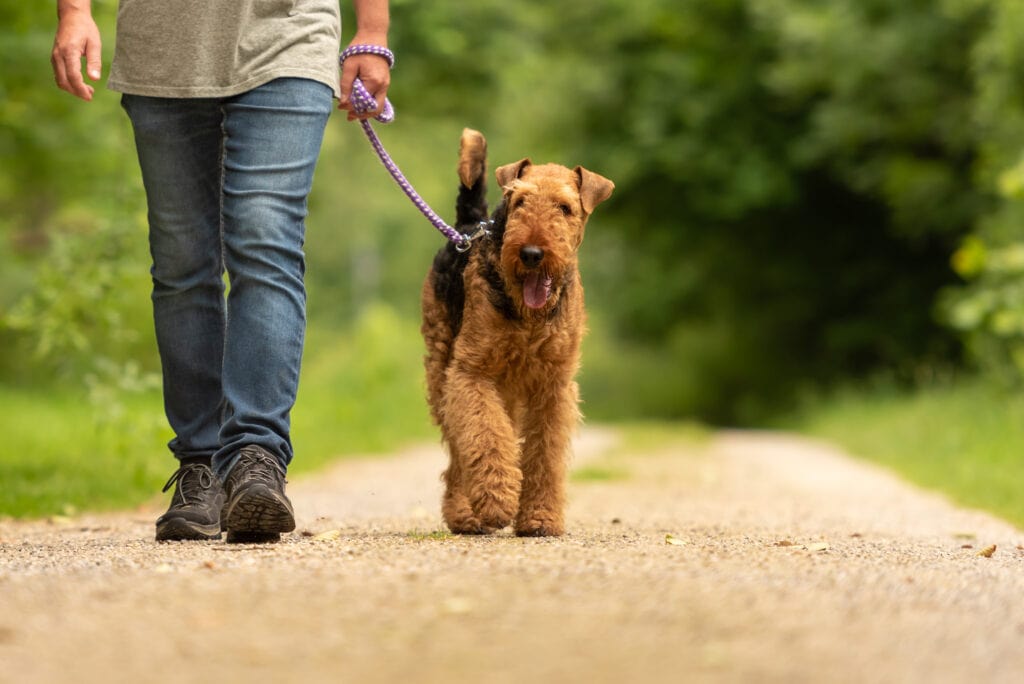
Step 5 – The Method
Essentially, we lure woof to our side, and you hold a treat or toy infront of his nose, and walk. One step, praise and reward.
Repeat, or if that was way too easy, go for a few steps.
praise and reward.
Repeat this.
Then as you’re seeing repeat success?
Add in a distraction. This might be walking past a beloved toy. Or your partner on the sofa. Or a guest. Or even just a treat laying on the floor waiting to be snaffled up!
Yep. simple stuff.
Increase the distraction. If you can? Amp it up until you have pup successfully walking past your kids, or your partner, singing and dancing.
If they’re struggling? Manage your distance from the distraction, or increase the amount of praise and reward.
Apply challenge slowly and make sure you’re confident they’re going to knock it out of the park, every time.
When you’re acing this? Move to a new, slightly higher distracting zone, like, your garden.
Repeat the above.
If your dog begins to pull
This is when you can get disheartened and revert. Don’t! It just means you’ve gone too fast. Take it back a step, decrease distraction and bridge the gap more slowly.
Or… be a tree.
This is where you anchor. Not a thing in this world or the next will move you. You are a mighty oak. The only thing that will move you? Is to feel that tension on the lead relax.
As soon as it does, praise, lure back for a reward.
Bring them back to a comfortable position alongside and begin again.
Or… U-turn
If the issue is a bigger issue than you think you can face? Turn on your heel and go the other way with a quick “This way!” and bounce off the other way. Most dogs will eagerly follow. Then, try again and praise and reward them for catching up and being in the right spot.
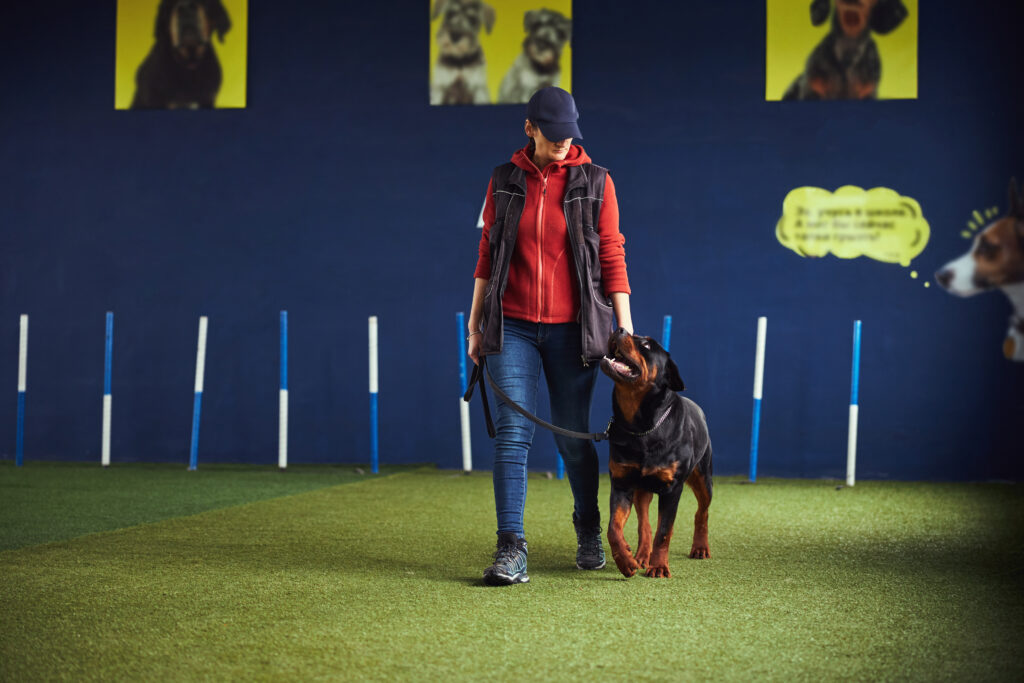
Step 6 – Practice
This sounds daft, but the more you practice? The quicker you’ll get it. The quicker your dog will get it. And, the quicker your shoulder will thank you.
It’s really not rocket science. It’s just understanding your dog, and what they want, and making them believe that doing it your way is more valuable than doing it the way he wants to do it.
Step 7 – Be Consistent.
Now, whether it’s just you walking or more people. You all have to sing off of the same hymn sheet.
It’s not easy, but the more consistent you are every day (yes, even on your tired days) and with everyone in your family or puppy care circle, the more reliable your dogs response will be.
You can totally phase out some of the treats. You can build to just give verbal praise or one or two treats every walk (but if you REALLY get into it? then you’ll keep the treats and just keep training other stuff!)
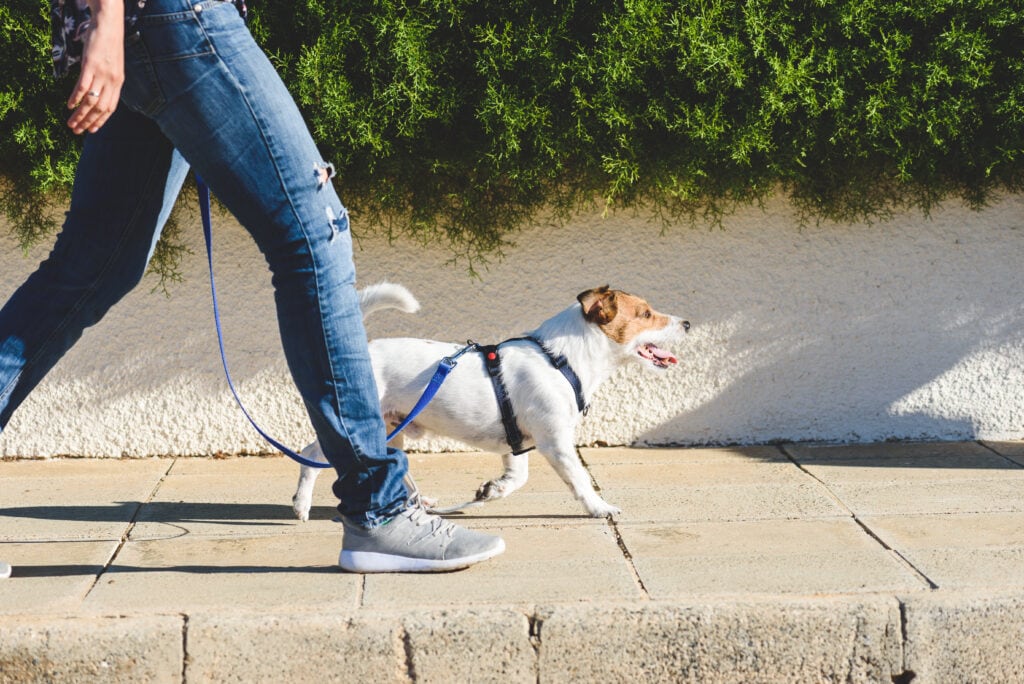
Question! Did You Notice I Didn’t Associate This With A Cue Word?
Well, gosh, now you mention it, Ali, I did!
Well, my dears, there’s a reason for that. The cue should not be a word but the leash.
The leash itself becomes the cue. Yep. Getting fancy now, huh?
As soon as that leash goes on this is an expected behaviour. No cue word required. And that’s what you will totally achieve, if you’re consistent.
Notes On Situational Pulling…
It’s often about understanding the cycle of reward to figure out why your dog is pulling. In each scenario below, I’ll illustrate why the dog pulls.
Dog Pulling To Go Home
Common reasons a dog pulls to go home
1 – they know their routine – i.e. they know when they get home, they get food! Food is what they live for so going home is very rewarding for them
2 – they don’t feel secure outside – if your puppy tends to be nervous or anxious and pulls frantically to get back home, then it could be that the world is pretty overwhelming for them. Look into gentle socialization first!
Each of these needs a different approach. If you need help figuring it out further? Let me know and we can book in a one to one.
Dog Pulling To Get To Other Dogs
This is almost always excitement (aka, other dog represents the most fun thing in the world) or fear (aka, the other dog represents a threat and needs to go away, now).
They’re actually treated pretty similarly, and it’s about being able to work with your dog when they can still focus on you and not the other dog.
We work at this distance and slowly decrease the distance, reassuring pup that they’re doing the right thing by paying attention to us, and not reacting to the other dog.

Dog Pulling To Sniff
This one is really obvious when you see it. That sniff? That is the reward.
If you’re trying to visualise the equivalent for me and you? Put a million pounds (or dollars) on top of the post box (mailbox) or beneath that tree… now you know why he’s pulling!
So, all you’re going to do in this situation is to use that smell as a reward as well. You’re not saying puppy can’t have his million dollar smell – you’re saying he can if he walks nicely. See the difference?
Tip: We can’t continuously deny our dogs they things they love. It makes for a sad dog, and a sad dog is one that’s harder to work with (unsurprisingly!) so, happy dogs are easier dogs. Remember that the next time you try and keep Fido walking straight past a smell he’s desperate for!
So, what you’ll do with the above procedure is to adjust it. Such that you act like a tree (stand still), wait for them to pay attention (or call them if need be), bring them back to you, reward them, and try approaching again.
Praise and reward whilst puppy is in the right spot.
Then, as you get to the smell? You’re showing he can have the best of both worlds, what he wants, and a whole bunch of treats and rewards too, if he does it your way and refrains from yanking your shoulder from it’s socket! (I’m talking largely to our Labrador Mums & Dads here!)
FAQ
Best Dog Harness For Stopping Pulling
Right, so, I’ve already said that harness won’t encourage pulling, but the best harness you can use whilst learning how to successfully walk on a loose leash – is a ruffwear front range harness.
These have two points, and work for dogs large or small.
The fact that it has two points (or leash attachments), where one is on the back, and the other is on the chest, means that your dogs strength is limited in it’s application. That front hitch stops them from moving a lot quicker than the one on the rear.
But if the front range doesn’t work for your dog for whatever reason Check out our Tried and Tested Best Harnesses.
What Harness Stops A Dog From Pulling?
None, proper equipment is not designed to stop a dog from pulling, it’s designed to ensure they cannot escape, are comfortable and protected. This way we maintain our dog’s wellness and confidence, as well as not forcing them to do what we want using the medium of discomfort or pain.
However, the best harness for teaching a loose leash walking (as mentioned above) is the ruffwear front range.
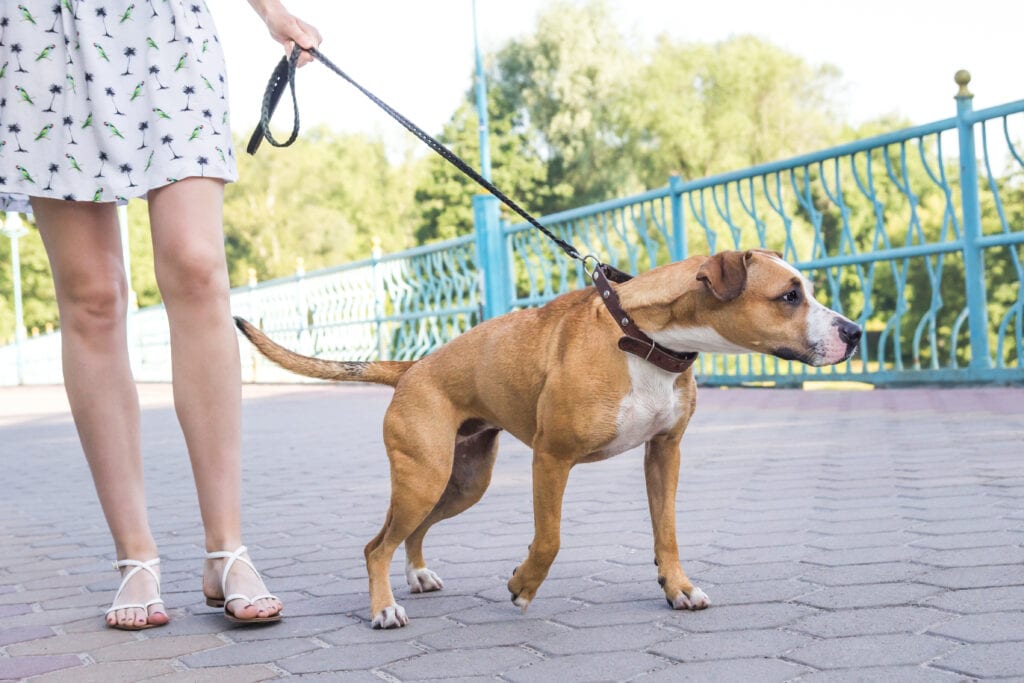
What’s Best To Stop My Dog Pulling?
Training.
Follow the method above, and you’ll start to see results so long as you put in the work.
What Lead Stops A Dog Pulling?
None, sadly! There’s only one thing that stops a dog from pulling, and it’s training, sorry! That said, the method in this post is tried and tested, if you’re willing to put in a little time and effort, (for which your shoulders will thank you!) you can have a dog who walks perfectly on leash.
Is It Safe To Walk A Dog That Pulls While Pregnant?
No.
This is a pretty simple one, but if your dog pulls, and catches you unaware, and you fall? Or anything similar to this, it’s just not worth the safety of yourself and your baby for a dog that’s pulling on leash. It’s a good idea to make sure that this is in order before falling pregnant, but remember that a dog walker may be able to alleviate the strain or trainer to help you get it right.
Can Pulling On A Leash Hurt Puppy?
It sure can, that’s why it’s important to teach a loose leash from a young age and to get it right. Their necks and bodies are growing and developing so continued strain is something that can take a greater toll at this age than later in their life.
Why Does My Dog Pulls On Leash To The Point Of Choking?
Because he or she wants to get somewhere, and the lure of getting to that place is more rewarding than the pain or discomfort the choking is being – it’s really worrying though, huh?
Well, it can do damage. So be aware that what’s causing the issue is the misbalance in one of the 3D’s of training, go back to basics and figure out where your misalignment is.
My Dog Barks Whilst He’s Pulling On A Lead, Is That The Same?
No, this sounds like it’s escalated (or escalating towards) reactivity.
If your dog is a puppy, take it back in terms of socialisation, you may be advancing them quicker than they would like.
If your dog is grown, then consider either online training for reactivity, or going through the blog post on it.
This one is really not one to be taken lightly!
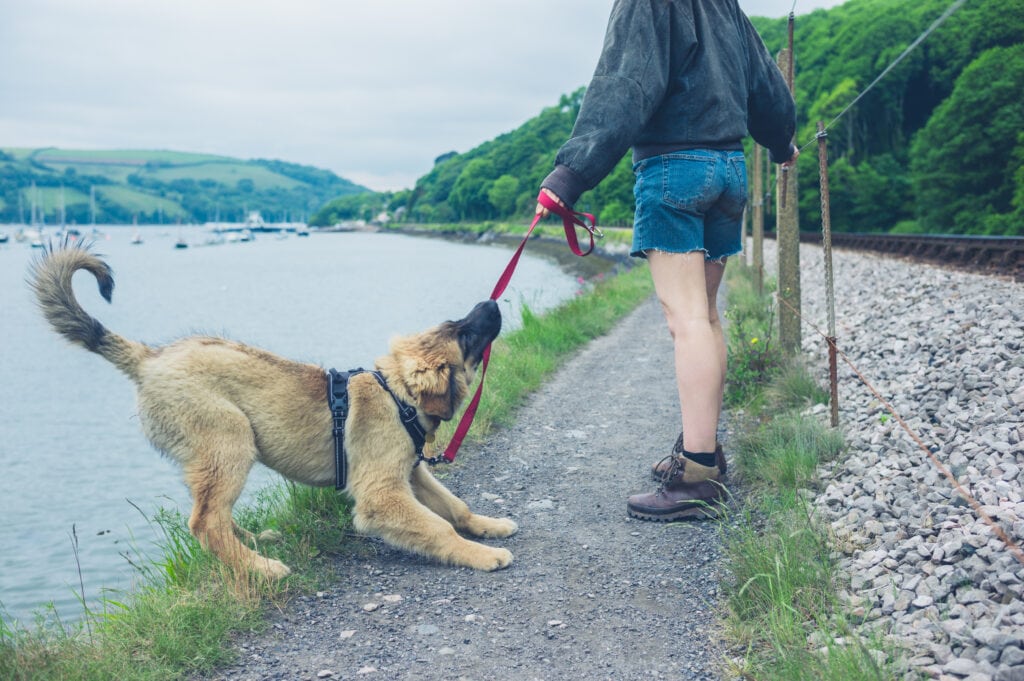
My dog is Pulling And Biting The Leash, What Should I Do?
Well, there’s a few reasons for biting the leash… let’s look at those.
- They want to play – consider using a tuggy toy whilst out for a reward.
- You’re moving too slow (they’ll need to learn patience so check above!)
- If they’re a retrieving breed, or a german shepherd, they may just like carrying things! Why not give them something to carry instead?
It’s pretty easy remedied in most instances, so don’t worry too much!
My Dog Is Still Pulling With A Gentle Leader, Why?
Because the pain and discomfort are not enough of a dissuasion vs the potential of getting where they want to go. You find this in a lot of breeds that don’t like to show pain, such as the Akita.
This means, you have to make being beside you and with you more rewarding and more appealing than where they want to go, as well as simultaneously stopping them from going where they want to go.
Try the training method in this blog as well as the equipment, you’ll find it’ll work better with much more reliable results!
Why Is My Dog Pulling Backwards On His Leash?
If he’s retreating then you’re doing something wrong. Whether he’s wearing a collar or harness, this is a situation that you’re going to want to put a stop to for safety reasons pretty quickly. If you’re worried about them escaping their harness, opt for a harness with a tummy strap, like the ruffwear webmaster or flagline. These will stop that escapable-risk.
To stop it, try walking in the direction your dog wants to go, and then turning back to the original direction.
If they still refuse to go, then there may be a larger problem at fault here. Don’t force them because you’ll make it worse.
If you want to discuss, do let me know, I’d be happy to book in a 1:1!
Can I Use A Prong Collar or Pinch Collar To Make My Dog Walk Nicely?
Try the training method in this blog as well as the equipment, you’ll find it’ll work better with much more reliable results. Prong collars can be used, but they achieve their results with pain and punishment (put bluntly) as opposed to guidance.
Much like children, dogs learn better with guidance than with punishment, and you don’t need a prong collar to achieve your goal.
Because the pain and discomfort are not enough of a dissuasion vs the potential of getting where they want to go. You find this in a lot of breeds that don’t like to show pain, such as the Akita.
This means, you have to make being beside you and with you more rewarding and more appealing than where that want to go, as well as simultaneously stopping them from going where they want to go.
Loose Leash Success!
By increasing everything in small increments, we can see success with a loose leash walk. It’s a great and marvellous thing that you can achieve – same as every other dog owner.
Honestly, you don’t need a new contraption, your dog isn’t broken, you just need time, patience and the right guidance – and that can be said for most things in the dog training world.
If you need assistance, help, or guidance applying this to your puppy, dog, or situation, book in a bark day. We can cover it in and we can get great results for you, if you’re willing to put in the effort, okay?

Author, Ali Smith
Ali Smith is a professional, qualified, and multi-award winning trainer is the founder of rebarkable. She has always believed animals deserve kindness and champions force free methods. Believing that dog guardians will all choose the kindest options if proper information is provided, she aims to help all dog guardians who need it and make dog training as accessible as possible
Ali lives win Maryland, US with her husband and her three dogs.

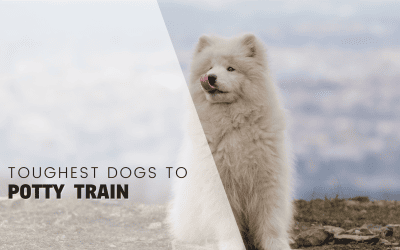

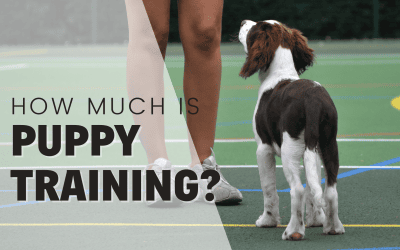

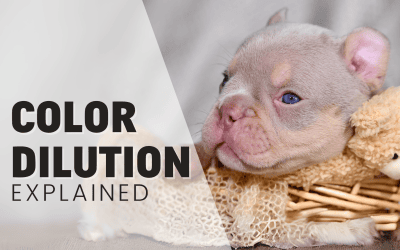
I’m struggling with my lab- so many squirrels, birds and bunnies that she’s almost pulling me off my feet! She will heel and check in with me without these distractions usually. I think we need to take our walk training back to the basics. Thanks for your ideas and maybe I’ll try a harness.
Hey Laura!
This happens for so, so many people. But this one is about practice.
So when you see a squirrel/bird/bunny that’s just doing it’s normal thing, and especially before your dog, increase your distance to it and work on relaxation around the critter – reward for focus and calm, lots of gentle praise, and try to leave without the critter springing away (because this will incite a chase drive) and you’ll conquer those springs away too with a little practice!
Also, try adding in more enrichment that mimics this for an outlet, flirt poles, fetch (even ground rolling balls) can be great outlets for your labs prey drive!
Great article and very good tips! You are my new favorite! I will enter daily to see the updates. What do you think about this Multifunctional Dog Leash from these guys? Thank you! Much love from Germany!
Hey Christina, no I don’t really recommend retractable leashes.
Here’s why!
My puppy has 2 torn CCLs and he just had surgery on the first one 2 days ago. He is pulling like crazy and so worried it will hurt him. Is it ok to try this method even though he can’t walk far or is this the best time to work on this?
Hey Julianne! What did your vet say about exercise? Personally, I’d focus on mental stimulation right now, particularly while he’s healing?
It can work, but I would really emphasise doing this in your home and making sure that you’re able to get past all sorts of incredible distractions before you move into your garden/yard.
Low distraction environments and plenty of practice will really help!
Great advice! I have 5 terriers, and they are pretty good when walked individually … but when I take a few together and they are excited about something they can be a handful.
Thanks Jitka! it’s hard walking multiple dogs – future post will cover that!!
Fabulous blog Ali, so many great ideas here x
Thanks Anna! Always important to keep your shoulder intact.
Wow so much to think about here. I’m glad I’m doing mostly the right thing with Patch and we have training on this too. We used to do the ‘tree’ too.
mostly is all you really need – being a tree is my favourite.
This is great advice which I’ll be trying out with my 15 month old Border Collie. He pulls with excitement when we go out but will walk lovely the way home.
Awwww Best of luck with Bertie! Excitement is a really tough thing for puppies.
Great article with a technique that works. It’s up to the humans to be consistent and the dogs will learn. My other favourite way is to lay down lids with a treat on the ground and take a step between each one. Gradually space the lids apart so you walk two steps, then three etc until you can go the whole way across the yard. 🙂
Ohh, that’s a good one! Glad you enjoyed it.